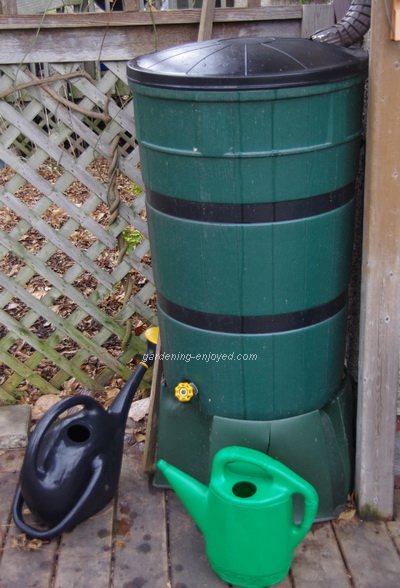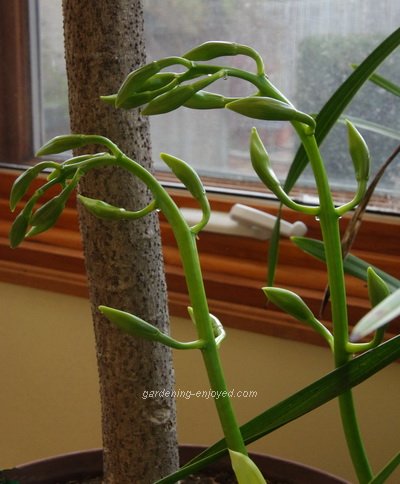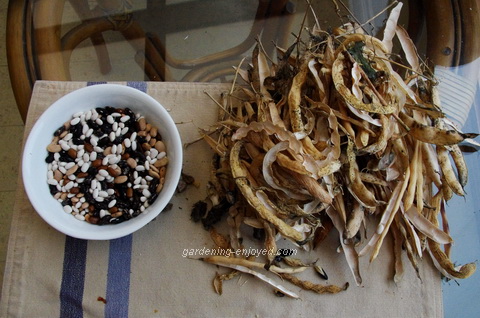| Back to Back Issues Page |
 |
|
Dallying In The Dirt, Issue #243--- It's time to empty the water barrels. December 08, 2015 |
 While I was outside, I decided that I had better attend to one important chore before things really did freeze. I have a couple of water barrels that collect rain water for the containers all summer. They need to be emptied and cleaned before they freeze solid in the winter. Freezing when they are full could easily crack them and besides, all of that water has some great uses at the start of the winter. Everywhere that I planted bulbs this fall will get another good soaking to make sure that those bulbs can develop lots of healthy roots so that they are ready to explode with all their colourful blooms next spring. All of my evergreens will also get well soaked with that collected rain water. They need a large supply of water in their soil to survive until spring. They use very little of it during the winter and the actual cold temperatures don’t really bother most of them. We saw a lot of winter damage on those evergreens this past spring but in most cases it was not a
direct result of the cold. In the late winter and early spring the sun shines longer and warmer. Those warming rays of the spring sun, wake up the needles and leaves on our evergreens and they start the process of transpiration. That is, the passing off of water vapour and the drawing from the soil, fresh water filled with nutrients. The long cold winter had the soil so heavily frozen that those plants’ call for fresh water could not be met. That’s when the needles started to dry out and turn brown. Making sure that the soil is well saturated now will help to mitigate that damage.
While I was outside, I decided that I had better attend to one important chore before things really did freeze. I have a couple of water barrels that collect rain water for the containers all summer. They need to be emptied and cleaned before they freeze solid in the winter. Freezing when they are full could easily crack them and besides, all of that water has some great uses at the start of the winter. Everywhere that I planted bulbs this fall will get another good soaking to make sure that those bulbs can develop lots of healthy roots so that they are ready to explode with all their colourful blooms next spring. All of my evergreens will also get well soaked with that collected rain water. They need a large supply of water in their soil to survive until spring. They use very little of it during the winter and the actual cold temperatures don’t really bother most of them. We saw a lot of winter damage on those evergreens this past spring but in most cases it was not a
direct result of the cold. In the late winter and early spring the sun shines longer and warmer. Those warming rays of the spring sun, wake up the needles and leaves on our evergreens and they start the process of transpiration. That is, the passing off of water vapour and the drawing from the soil, fresh water filled with nutrients. The long cold winter had the soil so heavily frozen that those plants’ call for fresh water could not be met. That’s when the needles started to dry out and turn brown. Making sure that the soil is well saturated now will help to mitigate that damage. I have these large pots of ugly strap shaped leaves that spend the summer in the back alley. They get watered and fertilized regularly despite their rather decrepit appearance. Now the rewards start. The earliest of those Cymbidium Orchids are putting up huge bloom stalks with several buds on each. The early ones are usually a bright yellow variety that should enliven the solarium in the next week or so. Orchids for Christmas, what could be better. There are two other varieties that are mostly white and they should be in bloom by mid January. These large flowered Orchids will stay in bloom for about 3 months, keeping us in flowers throughout most of the winter. I can see the biggest pot is putting up four flower stalks, it should be just dazzling when they open. A few of them are also bursting out of their pots and that means dividing and repotting them next spring when they go outside. I find the extra pots
created are sometimes difficult to give away. I need to keep pictures of them, in bloom, to show people what they are turning down. A pot filled with brown and yellow spotted leaves just doesn’t have any sales appeal, even free.
I have these large pots of ugly strap shaped leaves that spend the summer in the back alley. They get watered and fertilized regularly despite their rather decrepit appearance. Now the rewards start. The earliest of those Cymbidium Orchids are putting up huge bloom stalks with several buds on each. The early ones are usually a bright yellow variety that should enliven the solarium in the next week or so. Orchids for Christmas, what could be better. There are two other varieties that are mostly white and they should be in bloom by mid January. These large flowered Orchids will stay in bloom for about 3 months, keeping us in flowers throughout most of the winter. I can see the biggest pot is putting up four flower stalks, it should be just dazzling when they open. A few of them are also bursting out of their pots and that means dividing and repotting them next spring when they go outside. I find the extra pots
created are sometimes difficult to give away. I need to keep pictures of them, in bloom, to show people what they are turning down. A pot filled with brown and yellow spotted leaves just doesn’t have any sales appeal, even free.Now it’s time to answer a few of my reader’s questions. Don’t forget to check the front page of the Website for frequent short ideas for current gardening activities. Claire Asks? My indoor palm tree is looking rather poorly. The bright green colour is fading and it appears to have many tiny brown or white spots on all the leaves. |
| Back to Back Issues Page |
